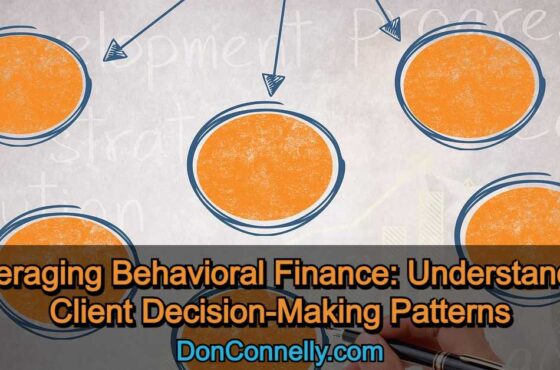First Meeting with a New Client—Preparation Checklist
 The first meeting with a new client should be a momentous event for both you and the client. For your client, it’s the first opportunity to validate their decision to select you as their advisor. For you, it’s the first opportunity to showcase your professionalism and reinforce your new client’s decision. You both hope this will be the beginning of a long and trusting relationship.
The first meeting with a new client should be a momentous event for both you and the client. For your client, it’s the first opportunity to validate their decision to select you as their advisor. For you, it’s the first opportunity to showcase your professionalism and reinforce your new client’s decision. You both hope this will be the beginning of a long and trusting relationship.
As you prepare for your first client meeting, it’s critical to remember that you are being carefully evaluated. Your new client is essentially taking a leap of faith in choosing you, and you must always strive to make them feel like they have made the right choice. With that in mind, your first meeting sets the tone for the entire relationship. Plan it with care.
First client meeting objectives
In setting an agenda for the first client meeting, you must be clear on what you and your client want to achieve. At this stage, you may know some things about your new client, but you don’t know everything you need to determine how you can help them. Your new client wants to get a feel for how you work and whether you’re the one who can help them. You can’t discuss your process until you clearly understand your client’s needs, concerns, and priorities. So, your agenda should be arranged to get the answers you both need.
Your agenda should be structured to allow your new client to do at least 75% of the talking by answering your questions about themselves, their life ambitions, and what’s important to them. You should ask them what they’ve already done, if anything, to secure their goals. You should already know some things about your new client through prior discussions. Now is the time to dig deeper.
With a clear understanding of what your client wants to accomplish, you explain your process and the next steps. This discussion should culminate in creating a prioritized list of action items. It’s also an opportunity to set expectations and goals for your relationship and reinforce how you bring value to it. The primary purpose of your first meeting is to have it lead to a second meeting where the actual planning begins.
First meeting action steps
- Arrange to have your planning team and staff available to meet your clients shortly after they arrive. This will make them feel welcome and more comfortable, and it also reinforces the notion that when they hire you, they are hiring your whole team. It’s essential they know all the people with whom they may work.
- Allocate the first ten minutes to talking about your client’s lives. You should already have notes about family members, jobs, hobbies, and other interests in your CRM. Use the time to establish rapport and find opportunities to connect personally.
- Next, revisit any issues covered during conversations you had before becoming a client. Discuss and confirm their financial priorities and find out why they’re important to them. This discussion should take up the majority of the time you have allocated for the meeting.
- Take the last fifteen minutes to map out your process for working with them, checking for their understanding and agreement along the way.
- Be specific about the next steps and a timetable for completing the planning work.
- Confirm their communication preferences and assure them you are available at any time.
- Remind them that it is a collaborative process and that their participation is critical to the relationship’s success.
- It’s also an opportunity to set clear expectations for each other.
- Review your fee structure and the value they can expect to receive in return.
- Emphasize that your only measure of success is helping them achieve their financial goals.
- Finally, schedule the next meeting and provide your clients with a list of actions to complete before the next meeting, including gathering financial documents and completing a questionnaire.
The Critical importance of post-meeting follow-up
Your post-meeting follow-up is an extension of your first client meeting. It must be executed flawlessly to reinforce your professionalism and commitment to your new client. At a minimum, your post-meeting follow-up should include:
- Update your CRM with all information obtained in the meeting.
- Schedule the next meeting.
- Schedule a brief follow-up call within 48 hours and a meeting reminder call five days before the next meeting.
- Assign project tasks with a timetable in CRM or project management program.
- Check in with your client (phone or email) within 48 hours to thank them again for their time and see if any questions have come up since the meeting.
- Create a post-meeting letter thanking the client again and recap the meeting and next steps. Include any deliverables promised in the first meeting.
Having a systematic approach to setting and executing your first client meeting agenda as well as your post-meeting follow-up will ensure the best possible experience for your new clients.
Watch this 3-minute video to learn how our 24-step training program can help you develop and hone the most important habits you must adopt in order to survive and hopefully thrive in a competitive and challenging industry.
See program details and enroll today!
Available as a self-paced program (always open) or as a 12-week coaching program (open only a couple of times a year), this training will change the way you view your practice and will help you reach new heights. Select your format and join today!



